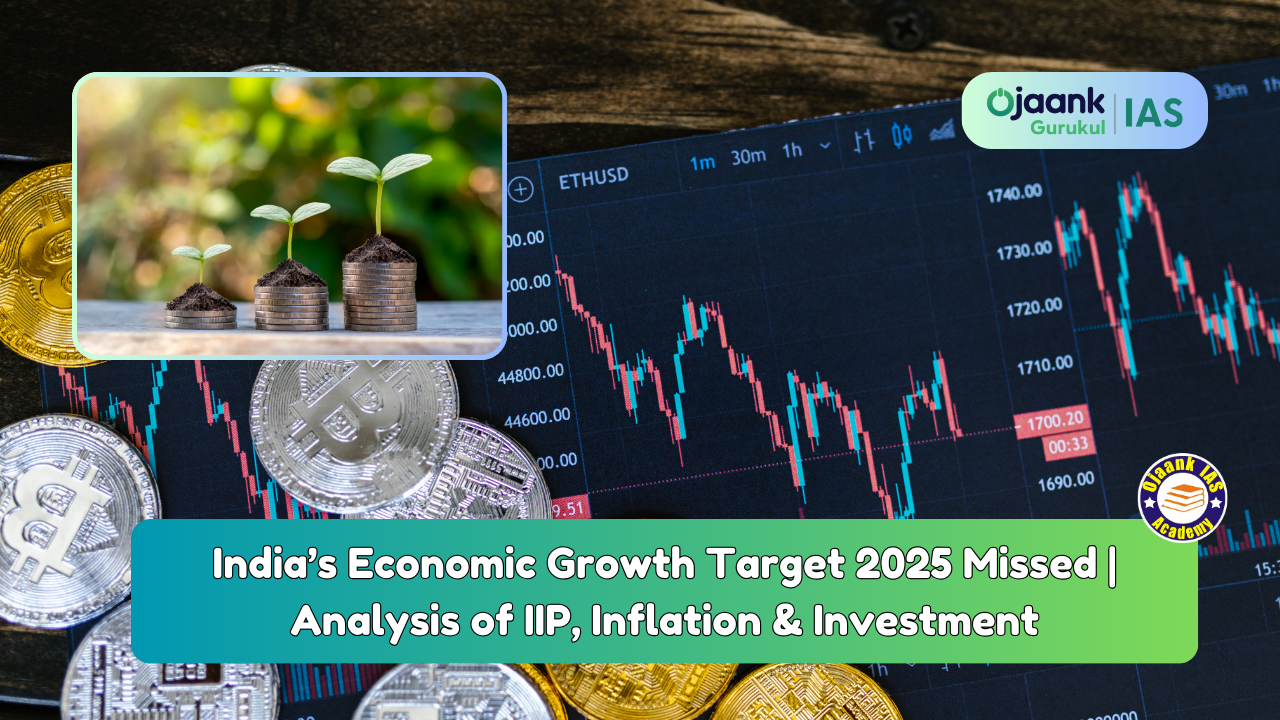India’s Economic Growth Target 2025 Missed | Analysis of IIP, Inflation & Investment

Introduction: Growth Target Missed, But Hope is Not Lost
In an economy as dynamic and complex as India’s, the occasional slip from a projected growth trajectory isn’t uncommon. February’s industrial production figures revealed that India might just fall short of the Centre’s ambitious 6.5% GDP growth target for FY 2024-25. But a closer, more nuanced look at the data tells a more hopeful story.
Despite mounting global economic uncertainty, a volatile stock market, and sluggish consumer demand, the Indian economy is still demonstrating notable resilience across key sectors. This blog breaks down the latest data from India’s Index of Industrial Production (IIP), the Purchasing Managers' Index (PMI), and other macroeconomic indicators to present a clear, SEO-optimized view of where India stands in April 2025.
1. Industrial Production Growth Hits a 6-Month Low
In February 2025, India’s IIP growth dropped to 2.9%, marking a six-month low, compared to 5.2% in January and 5.6% in February 2024.
 Breakdown by Sector:
Breakdown by Sector:
-
Mining: Collapsed to 1.6%, compared to 8.1% last year.
-
Manufacturing: Fell to 2.9%, down from 4.9% YoY.
-
Electricity: Marginal improvement at 3.6%, but still lagging behind last February’s 7.6%.
This decline across sectors—except power—hints at subdued demand and declining output capabilities, especially in manufacturing, which constitutes 77% of the IIP.
2. Consumption Slows Down Despite Falling Inflation
India’s retail inflation has been easing, standing at 3.61% in February, down from 5.09% the same time last year. Food inflation also cooled to 3.75%, the lowest in two years. But surprisingly, this has not sparked a consumer spending boom—even with events like the Maha Kumbh expected to provide a boost.
 Consumption Trends:
Consumption Trends:
-
Consumer durables output: Dropped to 3.8%, from 12.6% YoY.
-
Consumer non-durables: Contracted by 2.1%, following a 3.2% contraction in January.
These figures indicate weak consumer sentiment, possibly due to household financial stress from volatile stock markets and a cautious attitude toward large purchases.
3. Manufacturing PMI Reflects Slowing Growth
The S&P Global Manufacturing Purchasing Managers’ Index (PMI) for February stood at 56.3, a 14-month low, further aligning with the weak IIP numbers.
 Why This Matters:
Why This Matters:
-
PMI below expectations = lower factory orders.
-
Sign of dampened business confidence, especially among small and mid-scale manufacturers.
-
Reflects uncertainty caused by global geopolitical tensions, trade restrictions, and currency fluctuations.
4. Global Influences: Capital Flight & Asset Volatility
The foreign capital outflow from India has significantly pressured the rupee and liquidity levels.
-
Foreign investors pulled funds due to rising interest rates in the U.S. and a flight to safe-haven assets.
-
Indian markets have mirrored this volatility, hitting consumer confidence hard.
 Liquidity Crunch:
Liquidity Crunch:
-
₹1.7 trillion liquidity squeeze recorded in the banking system (as of Feb 20).
-
RBI's intervention: Injected ₹2.18 trillion via rupee-dollar swap arrangements to restore balance.
Despite these shocks, the Reserve Bank of India has acted decisively to stabilize liquidity and exchange rates.
5. Green Shoots in Investment & Core Industries
Despite headwinds, some sectors have defied the downtrend.
 Top Performing Industries (YoY growth in Feb 2025):
Top Performing Industries (YoY growth in Feb 2025):
-
Motor Vehicles, Trailers, Semi-Trailers: +8.9%
-
Non-metallic Mineral Products: +8%
-
Basic Metals: +5.8%
 Capital Goods Output:
Capital Goods Output:
-
Soared to 8.2%, up from 1.7% a year ago—clear evidence of strong investment activity, especially infrastructure push from the government.
This growth in capital goods—a key proxy for investment—suggests that while consumers might be cautious, businesses are continuing to invest, and government projects are moving full steam ahead.
6. Government’s Role: Spending as a Stimulus
One of the most significant contributors to this resilience has been government-led capital expenditure. Major infrastructure projects, PLI (Production Linked Incentive) schemes, and strategic disbursements have kept the economy from stalling.
Even if the 6.5% GDP growth target is missed, India still retains its title as the fastest growing major economy in the world.
Conclusion: Growth Missed, Momentum Intact
India’s industrial slowdown in February is a wake-up call, but not a death knell. The broad dip in IIP, slowing consumption, and manufacturing anxiety are real concerns, but they are offset by strong investment activity, sector-specific resilience, and decisive central bank interventions.
Yes, the Centre’s 6.5% GDP target for FY25 may be out of reach, but India’s economic fundamentals remain intact. As global headwinds ease and domestic policies adapt, the economy still holds massive potential.
 Key Takeaways:
Key Takeaways:
-
India’s IIP dipped to 2.9%, a 6-month low.
-
Retail inflation dropped to 3.61%, but consumption didn’t rise.
-
Capital goods output up by 8.2%, driven by government spending.
-
RBI injected ₹2.18 trillion to ease liquidity.
-
Despite missed targets, India remains the world’s fastest growing economy.